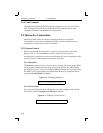
Using the MSS Incoming Connections
5 - 1
5 - Using the MSS
This chapter explains how to use the MSS interactively and with host
applications. Host-initiated (incoming) connections include:
¥ Making socket connections to TCP/IP and IPX/SPX hosts.
¥ Making LAT connections to VMS, Ultrix, and OSF/1 hosts.
¥ Using host applications with the MSS.
¥ Using the code examples included with the MSS.
Interactive uses include manipulating sessions, making outgoing
connections, and viewing server and network information with the help of
the Show commands.
In addition, explanations are provided for:
¥ Setting up two MSS units to emulate a direct serial connection over the
LAN.
¥ Using the MSS as a data pipe between a serial device and multiple
hosts on the network.
5.1 Incoming Connections
5.1.1 Socket Connections
Each node on a network has a node address, and each node address can allow
connections on one or more sockets. Sometimes these sockets are referred to
as ports. TCP/IP and IPX connections can be made directly to the MSS serial
port using sockets.
There are two categories of sockets. Well-known sockets are those that have
been deÞned in RFCs (Requests for Comments); for example, port 23 is used
for Telnet connections. There are also custom sockets that users and
developers deÞne for their speciÞc needs.
NOTE: If the serial port is in use, the socket connection will be refused.


















